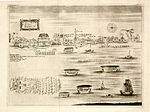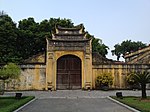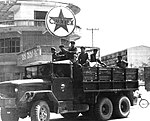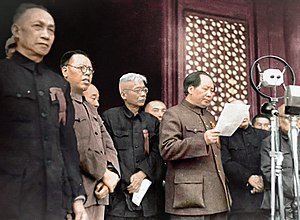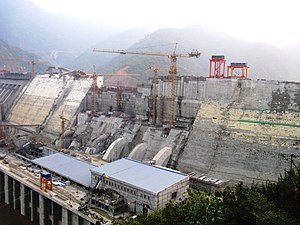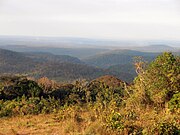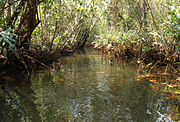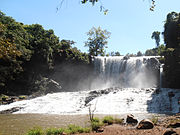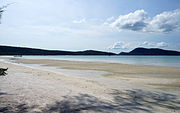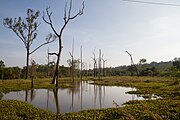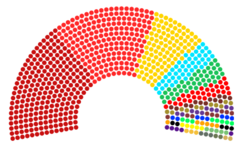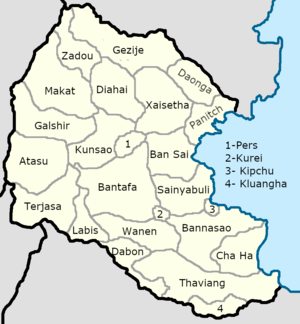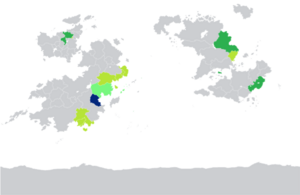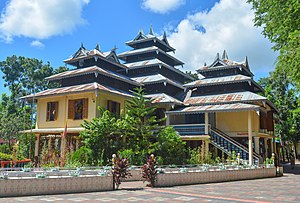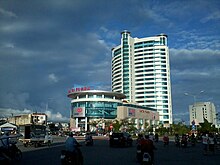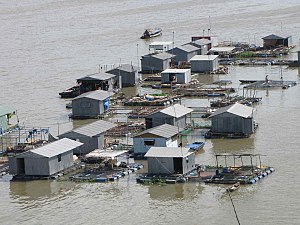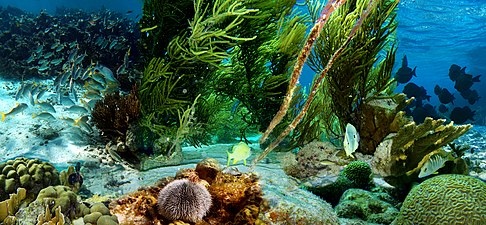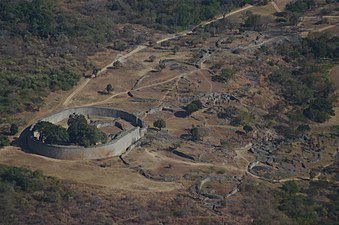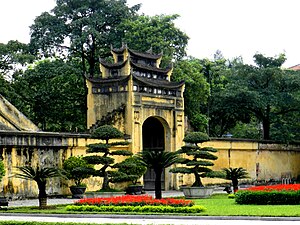Lavana: Difference between revisions
No edit summary |
No edit summary |
||
| Line 398: | Line 398: | ||
Renewable energy has been a growing field in the country, primarily hydroelectric power, Lav San Dam first started building in 2004 and finished in 2015 is the largest dam in Southeast Coius, and provides 80% of Lavana's total hydroelectric power output. The dam was seen as a highly ambitious project as it was the first large scale dam project in Lavana, but its successful construction and results have led to wider development in the area, with multiple projects seeking to expand on the success of the dam. Other sources of energy although limited have slowly grown in importance, the government has approved 10 Gw worth of solar power plants in the nation to be installed between 2015-2025, the move marked as highly ambitious has met great results with a steady rise in solar power produced and a general decline in the cost of electricity primarily in the west of the country where nuclear energy is not as efficient. | Renewable energy has been a growing field in the country, primarily hydroelectric power, Lav San Dam first started building in 2004 and finished in 2015 is the largest dam in Southeast Coius, and provides 80% of Lavana's total hydroelectric power output. The dam was seen as a highly ambitious project as it was the first large scale dam project in Lavana, but its successful construction and results have led to wider development in the area, with multiple projects seeking to expand on the success of the dam. Other sources of energy although limited have slowly grown in importance, the government has approved 10 Gw worth of solar power plants in the nation to be installed between 2015-2025, the move marked as highly ambitious has met great results with a steady rise in solar power produced and a general decline in the cost of electricity primarily in the west of the country where nuclear energy is not as efficient. | ||
=== Mining === | |||
Although mining has existed since antiquity it has not been a key sector in the Lavanan economy, Gaullican attempts at increasing production of {{wp|coal}} reserves found in the Gezije range were largely unsuccessful, and Lavanan has primarily mined minor amounts of {{wp|iron}}, and {{wp|copper}}. In the 1970's growing interest in the sector resulted in studies conducted by the central government which found unexploited reserves of {{wp|bauxite}}, {{wp|chromium}}, and {{wp|zinc}} resulted in wide investment by the central government, this resulted in the establishment of the ສະພາຂຸດຄົ້ນບໍ່ແຮ່ແຫ່ງຊາດ (National Mining Council), a state owned enterprise tasked with managing the mineral resources of the country. By 1996, Lavanan production of bauxite, chromium, and copper had nearly quadrupled, with the nation becoming a key exporter of bauxite on the global market with large reserves still unexploited. This rapid expansion was seen favoredly by the central government as a key way of obtaining foreign {{wp|Hard_currency| hard currency}}, and allowing for warmer relations between Lavana and foreign nations. Mining is conducted wholly by the state owned NMC, and foreign investment is carefully regulated. | |||
The expansion of mining has caused severe environmental issues, with waste from mineral operations usually dumped into the countries rivers, following government regulation this problem has been majorly eliminated by environment degradation, and deforestation remain a key issue. As most minerals are mined and transported through the river system for either export or processing, spills and leaks have occurred. In 2014 an iron ore transporting vessel collided with a fishing village on the Kung river capsizing and releasing several tons of the ore into the river causing great pollution along with several deaths, attempts at changing the transportation of minerals through railway has seen some success but still large amounts of minerals are transported via waterways. | |||
=== Transportation === | |||
[[File:Da Nang Dragon Bridge (II).jpg|thumb|right|Pers Bridge of the Yellow Dragon]] | |||
[[File:Metro 2A.jpg|thumb|right|April Remembrance Metro bridge in Pers]] | |||
=== Tourism === | === Tourism === | ||
<gallery mode=packed heights=150 style="font-size:88%;line-height:120%"> | <gallery mode=packed heights=150 style="font-size:88%;line-height:120%"> | ||
| Line 407: | Line 413: | ||
File:Citadelle de Hanoï (4).jpg|The {{wp|Imperial_Citadel_of_Thăng_Long|Thy Lucc Historical center}} in the center of Thy Lucc showcases the ancient capital of the Sao's which ruled over modern Lavana. | File:Citadelle de Hanoï (4).jpg|The {{wp|Imperial_Citadel_of_Thăng_Long|Thy Lucc Historical center}} in the center of Thy Lucc showcases the ancient capital of the Sao's which ruled over modern Lavana. | ||
</gallery> | </gallery> | ||
== Culture == | == Culture == | ||
[[File:Can Tho, Vietnam, Floating Market, Boats.jpg|thumb|right|Floating market on the Pekelo River]] | [[File:Can Tho, Vietnam, Floating Market, Boats.jpg|thumb|right|Floating market on the Pekelo River]] | ||
Revision as of 19:42, 21 April 2021
This article is incomplete because it is pending further input from participants, or it is a work-in-progress by one author. Please comment on this article's talk page to share your input, comments and questions. Note: To contribute to this article, you may need to seek help from the author(s) of this page. |
People's Republic of Lavana ສາທາລະນະລັດປະຊາຊົນລັດ ລະຫວ່າແ | |
|---|---|
| Motto: "ຈາກແມ່ນ້ ຳ ທີ່ຍິ່ງໃຫຍ່" "From the Mighty Rivers" | |
| Anthem: ດວງຕາເວັນແດງຂອງລັດ ລະຫວ່າແ (The Red Sun of Lavana) | |
 Location of Lavana on Kylaris in dark green | |
| Capital and largest city | Pers |
| Recognised national languages | Pasamnoan, Ziba, Ukilen, Veneran |
| Ethnic groups | Pasamnoan 61% Others 5% |
| Religion | Badi 52% Irreligion 30% |
| Demonym(s) | Lavanan |
| Government | Council Republic |
• Premier | Laina Keomany |
• Vice-Premier | Trang Dong |
| Legislature | Congress of Lavana |
| Establishment | |
• Formation of the Kingdom of Lavana | 1876 |
• Establishment of the Republic of Lavana | 1951 |
• Establishment of the People's Republic of Lavana | 1960 |
| Area | |
• Total | 713,879 km2 (275,630 sq mi) |
| Population | |
• 2020 census | 86,842,742 |
• Density | 121.65/km2 (315.1/sq mi) |
| GDP (PPP) | 2020 estimate |
• Total | |
• Per capita | |
| GDP (nominal) | 2020 estimate |
• Total | |
• Per capita | |
| HDI (2020) | 0.806 very high |
| Currency | Lavanan Dunan (LZ) |
| Date format | dd-mm-yyyy |
| Driving side | right |
| Internet TLD | .lv |
Lavana (Lavanan:ລະຫວ່າແ) officially the People's Republic of Lavana (Lavanan:ສາທາລະນະລັດປະຊາຊົນລັດ ລະຫວ່າແ) is a sovereign state in Southeastern Coius. It borders Dezevau to the north, the Brown Sea to the east, and tbd. With a total area of 713,879 km2, and population of 86.8 million people, its one of the largest countries by population in the world. It's capital is the city of Pers Lavana's most populous city as well as the country's economic, political and cultural centre.
Inhabited since antiquity, agriculture and language was brought by Ziban migrants and traders who expanded on Lavana utilizing the countries wide river system to establish centers of trade and the establishment of the first city states in the inland regions, while a distinct . The city states would eventually band together in various federations and empires usually centered on the centrally located city of Thy Lucc from which the Sasuanan empire began emanating power and influence from the 4th century BCE onwards. The Sasuanan Empire established the tradition of a centrally located aristocracy and center of power centralized on a Sao comparable to an emperor, such traditions would continue for several centuries. The Pasamnoans originally from the areas surrounding modern day Kuthina would begin their migration around the 8th century CE with many finding their ways as mercenaries towards the warring factions following the collapse of the Nukhao empire, Pasamnoan influence would reach its highest point when aristocrats and military leaders of Pasamnoan descent would establish a Pasamnoan king during the reign of the Damrog Empire in the 11th century. Weakening Damrog Empire influence and power would result in the rise the Aguda Empire in southern Dezevau from former Damrog holdings which would grow onto control most of Dezevau and Lavana.
The Aguda Empire would reach its apex in XXXX when it held vast influence and land throughout Coius, the arrival of Eucleans mainly Gaullicans into the region began a slow decline as foreign influences weakened its internal structure at points the Agudan Empire existing on paper while entities such as the Saint Bermude's Company from Gaullica managing the lands of the former Agudans as colonial holdings. The Kingdom of Lavana would be established in the aftermath of the dissolution of the Agudan Empire, the Kingdom of Lavana would remain a puppet of Gaullican and later Estmerish colonial administrators. Growing international pressure and the ranging war for independence would result in Lavanan independence 1951, the Republic of Lavana would suffer from growing tensions between democratic and socialist factions in its government resulting in a 1957 military coup and the start of the Lavanan Civil war, which would rage until 1960 when Socialist forces would declare the People's Republic.
Lavana would integrate into the international socialist movements alongside it's two close Socialist neighbors in Dezevau and South Kabu founding the Brown Sea Community in . In 1981 the country would be involved in an insurgency against steppe ethnic groups, which would only end in 1989. The country today is a developing economy, with close ties to it's Northern neighbor and other socialist states, the government has followed the trend of liberalization and opening up which followed after decline of Socialist countries in the 1980's and 90's. It has been a member of the AIS since it's inception in 1980.
Etymology
The term originates from the Pasamnoan combination of between lavang (ລະຫວ່າງ) and river aemn am(ແມ່ນ້ ຳ), Lavana means "between rivers" in the native Pasamnoan language. The term was popularized during the era of the Aguda Empire as the territories inhabited by the Pasamnoans were marked as being between the Siadng and Kalani rivers. Do to the constant interaction of the population with rivers and other waterbodies the term was quickly picked up by Euclean traders and used to refer specifically to the area in modern Lavana, and other areas in the Agudan empire where Ziba was not the main language. Upon separation from what would later become Dezevau following the collapse of the Agudan empire in 1866, the name Lavana was picked to represent the new Kingdom of Lavana established by colonial administrators.
History
Pre-history
| Lavana Timeline of Significant Eras | ||||||||||||||||||||||||
|---|---|---|---|---|---|---|---|---|---|---|---|---|---|---|---|---|---|---|---|---|---|---|---|---|
|
||||||||||||||||||||||||
Lavanan pre-history can trace itself to early human settlement along the various rivers of the region, agriculture can be traced to it's discovery in Dezevau, which slowly made it's way into Lavana. Early societies existed on the banks of waterways growing rice, and keeping livestock, they utilized the waterways to transport goods and conduct trade, waterways became very important to the Lavanans and became the basis for its religion, and society. This low scale settlements begun to slowly make alliances with neighboring settlements, and as settlements grew their influence helped keep the river safe, and trade flowing. From this settlements designed to provide aid to the population and the merchants the city-states of the region began to appear. The first remains of city-states date back to the 9th century B.C.E. from where they began to establish themselves. This settlements would fight each other for control of farmland and greater swaths of the river. The Duh Hoc culture which arose alongside the city states in the 9th century, is most known for their jars, which have been suspected to serve as their cemeteries, holding possessions along with the remains of individuals.
!Austronesian migrations dating back to the 8 through 4th century BCE from the south of Coius established settlements on Lavana's coast, this settlements quickly grew in influence and importance as key centers of trade with the wider trade network in Southern Coius. These city states increasingly warred with Ziban speaking entities in the mainland as control over the rivers was essential.
Sasuanan empire (3rd Century B.C.E-1st Century C.E.)
The city of Thy Lucc at the junction between the Kung and Siphadon rivers had by the early 4th century B.C.E., become among the most powerful city-states in inland Lavana, its vast power and influence were crucial in the empires growing control of the Kung river, Lavana's major transportation route. Aggressive military campaigns by Sasuana Lin the Sao of Thy Lucc and vast irrigation projects on the 3rd century expanded Sasuana's territory which by the time of his death in 316 BCE had carved a sizeable territory administered by Thy Lucc and a large federation of city states cemented the status of the Sasuanan Empire. The title of Sao taken as protector of Thy Lucc came to represent the position of power over the lands of Lavana. Over the coming years and successful Sao reigns growing Sasuanan influence would culminate in near total control of the Kung river for the empire which utilized this strength to acquire great concessions from the coastal cities which had tried to resist Sasuanan power but its vast population and control of the centre of the country made it increasingly difficult to combat the Sasuanans.
The Sasuanans would reach the peak of their power in 99 BCE with the reign of Sao Bis Lap which successfully reigned in much of the coastal city states under Sasuanan control or alliance. During his reign the construction of temples and shrines towards the 20 sisters from Lavanan mythology increased, alongside the first attempt at codifying a standard Ziban language although this attempts were soon ended following the death of Bis Lap in 61 BCE. The Lap dynasty he established would rule the Sasuanan empire until its demise. Following Bis Lap's death power struggles inside the empire began to weaken its central foundations as allied city states primarily coastal city states demanded further liberties and freedoms in their governance. During this time Steppe raiders became a growing threat, with Sasuanan gold used to bribe them from invading or raiding the empire, droughts and general loss of agricultural output cause a great strain on the Sasuanan economy. Its inability to provide food nor money for the empire would result large scale rebellion on the 5th CE, during this time Sao Nan Laps reforms regarding Sasuanan administration and the army provided the necessary funds and resources to utilize steppe armies, one of this armies led by Lao Va was crucial in retaking the city of Kila in modern day Laitaka, ending the rebellion in 10 CE.
The period of relative stability brought on following the civil war was quickly destroyed when Nan Lap died in 17 CE, leading to a 3 year civil war between his 5 sons as no clear successor could be found. In the end Nan laps youngest son Liz Lap would be crowned Sao in 20 CE using the help provided by Lao Va which had married Liz Lap and one of his daughters. Fearing that a foreigner now controlled the Sao, rebellion sparked again, Lao Va fought a grueling campaign the next decade against rebellion and city-states in southern Dezevau expanding the Sasuanan empire in that region. The death of Liz Nap in 33 CE, would result in the establishment of the Lina Dynasty which would rule the country under the protection of the steppe raiders. Infighting among the Sao and his steppe handlers would result in internal instability, finally culminating in general anarchy and conflict between 50 CE and 97 CE, when Pae Nukhao was crowned as Sao, establishing the Nukhao empire with the Nukhao dynasty at its head.
Nukhao empire (1st Century C.E.-8th Century C.E.)
The Nukhao Empire sought to reform that which had plagued the Sasuanan Empire, religious freedoms were allowed and foreign religions began to enter. Most prominently Badi from neighbouring Dezevau which had been prosecuted before but found easy growth in Nukhao, with it blending with the Lavanan Mythology creating what is referred to as Lavanan Badi.
The Nukhao feared the instability of the steppe and began in the 2nd century a series of expeditions into the steppe to establish friendly tributary states to become buffers for the Empire. Badist traders made their way into these states and slowly began to convert, Badi travelled through the trading networks in a process called the Badization of the Steppe, as Nukhao emperors thought that they could "pacify" the steppe through the conversion into Badi.
The Sao was under heavy influence from the First Zapoten League, which began to slowly diverge in interests, by 136 disputes between some members in the league would result in conflict with the Sao tasked with solving the conflict through the aid of one faction or the other. Such conflicts slowly eroded the credibility of the league and divided it's efforts in ensuring loyalty in the Sao and the inland cities. The Sao would in 159 launch a 8 year long war against the Zapoten League which was forced to establish itself again, amid rocky relations within it's members, the coastal cities could not defeat the Sao but the growing toll of the war on the Empire, and fears that any sign of weakness could cause the buffer states to free themselves from Nukhao influence. An unsteady peace was reached which cemented the Zapoten League independence as a tributary state but maintained their control in Thy Lucc, and the Sao.
With the perceived defeat of the Sao, large moves to devolve the power of the Sao occurred making the position mostly a ceremonial one. For the next 200 years the Sao acted as a rocky stabilizer of the many cities which would constantly feud with one another, with only minor warfare between them. During this time Lavanan rice farmers were hit with bad harvest which led to widespread famine in the 4th century, it is estimated that some 50,000 people succumbed to the famine during a period of 20 years. Following the large scale famine, the Sao established itself as a powerful force in 378 after having defeated the First Zapoten League in battle and forcibly disbanded them. With memory of the famine just 10 years prior, the Sao began the construction of a widespread canal system in the country, with the goal of stimulating the crashing economy, and ensure easier access to the waterways to farmers. Such projects were expected to secure the power of Thy Lucc and the Sao as the connection between the Siadng, Kung, and Kalani rivers.
During the reign of Sao Vasja Lina in 400, the laws of the Nukhao were rewritten and codified in the so called Lavanan Ziba. Such a move was important as Ziba had been spoken with a variety of dialects and laws were usually written depending on the dialect of the scribe or the creator of the law, some laws were in foreign languages with laws pertaining to the Va Dynasty remaining largely ineligible as translators could not be found to interpret the laws which had been written in X language, some codes pertaining to trade were written in Xiaodongese as Xiaodongse was much easier to understand for foreign traders than the local Ziban dialect. The move made the Nukhao Code of laws much more accessible for the population and made translations much easier, allowing the code to be translated to numerous languages to allow for easier foreign understanding of Nukhao Code of Law.
Classical Kungian Period (7th Century-12th Century)
Late Kungian Period (12th Century-14th Century)
The Aguda Empire
Colonial Period and the Kingdom of Lavana
Great War
Estmerish mandate
Following the defeat of Gaullica, Lavana fell under the control of Estmere, as Lavanan soldiers returned from overseas they found themselves serving under their previous enemies. The Sao was allowed to continue on his position and welcomed the arrival of Estmerish authorities in the hopes of calming civil strife in the country, the Sao found himself with an undermanned and understaffed Estmerish contingent unable to manage both Dezevau and Lavana, the Sao royal guard was expanded to make up for Estmerish undermanned forces. Following the independence of Dezevau Estmerish forces were brought in to reinforce and train royalist forces in the face of growing threat from the Coalition for a Free Lavanan, it was estimated that 13% of the countryside was under CFL control, a Royalist offensive in the summer of 1939 found little success in reconquering LDL territory, the CFL retaliated by murdering Estmerish High Commissioner to the Sao Ivan Lloyd in 1940 prompting large Royalist movements into the countryside which found little success.
CFL activities were at the time greatly concentrated in the Ziba speaking part of the country as support from Dezevau was acquired, but the growing influence of Dezevau and its socialist government resulted in greater power and influence for the Socialist forces which found themselves benefited directly by Dezevauni support, repeated Sao attempts at targeting Ziba speaking communities caused outcry by socialist states. Estemerish economic and military aid towards the Sao increased as fear of further international aid might cause a succession of revolutions to explode in Coius, such efforts were cut abruptly short with the start of the Solarian War which saw Estmerish forces relocated from Lavana to other fronts to aid the war effort. Droughts between 1942 and 1945 impacted the south east of the country resulting in famine like conditions for many poor farmers, such situations led to a large scale civilian migration towards the cities, the Sao was unable to quell the growing unrest and several CFL attacks on cities most primarily Edrona which was under CFL control for an entire month in 1945 until Royalist and Estmerish forces which had been further reduced at the end of the Solarian war retook the city, to heavy casualties on the CFL side which lacked the aerial and artillery support available to the Royalists.
Sao Thy Atith would die on June, 1950 his son the 16th year old Lin Atith was next in succession but fears regarding the boys mother which had been imprisoned for fears of being a CFL sympathizer just a few months prior, caused Estmerish authorities to install Thy's uncle Oke instead causing a power struggle inside the royal family. Fighting broke out between Lin and Oke loyal forces giving the opportunity for the CFL to retake lost territory, although fighting was over by July with a clear victory for Oke. On October 1950 Lavanan exile and leader of the Lavanan Section of the Workers International Saravan Khouph gave a speech decrying Estmerish colonization and the brutal rulership of the Sao, pressure increased for Estmere and other Euclean powers to decolonize. A CFL attack on Pers on December 1950 and a general offensive the month after saw large sections of the Royalist army some loyal to the former Lin defect with some joining the CFL. Oke agreed to a national referendum regarding the establishment of a republic for the 19th of August along with a general election the month after shall it pass. Estmerish forces under international pressure agreed to pull all military forces from Lavana regardless of outcome by December 31st 1952. A general victory for a republic on the national referendum finalized the Kingdom of Lavana, and the position of Sao.
Republic of Lavana
Although the CFL had accomplished it's goal inner fighting soon began in the parliament, although the People's Democratic Party remained in the CFL in Parliament it was an independent entity. Soon the democratic forces also split between the rightwing Democratic Front, and the nationalistic Lavanan Freedom Party (PDP). The LFP collaborated with the PDP as they feared the close ties between the Democratic Front and rich landowners, along with the remaining Guallican's and Solarians which both parties saw as coming close to the Triumvirates power base. The election of Sin Duon as President in 1943, was seen as a compromise as Sin Duon did not have the ties to the rich landowners Makaio Sayasone held. the LFP struggled after 1945 to reach much of a compromise with the PDP which became more extreme in their rhetoric as they saw Sin Duon as nothing but a continuation of the same as before.
The PDP itself split in 1946, into the People's Revolutionary Front (PRF), after Oke Syrypanha expulsed the most extreme of the party citing their growing divergence from democratic and socialist ideals. Such split weakened the PDP, but gave the LFP the necessary confidence in closer ties with the party. The 1947 elections were seen as the time to bring closer ties between the LFP and it's Lavanan Urban base and the rural PDP supporters together into a single candidate to oppose Makaio after announcing his intention to run, following Sin's single term as President. The 1947 election saw 3 candidates running for office, Makaio from the Democratic Front, Kye Seeha from the PDP-LFP, and Vũ Thế Anh from the PRF. Although the PDP-LFP foresaw a victory, the Democratic Front won the contest, the PDP-LFP requested a recount of the votes as some provinces were won by as little as 500 votes. Something the supreme court rejected, the PRF denounced the Democratic Front after it was revealed the existence of people registered in different polling stations and voting multiple times, the election results were widely rejected and protested by the PRF and PDP, but the LFP decided to acknowledge the results so as to prevent conflict, hoping to defeat Makaio in the next election.
With growing tensions between all 4 parties, and the inability of Makaio to secure a majority to pass legislature even among his party, resulted in his resignation in 1948 which would trigger an election. As he had not served a full term he was able to run for president again, in the election of 1948 the PDP and LFP ran as the same party despite their growing conflict with one another, Saravan Khouph was chosen as the candidate. The PRF ran Vu again. The elections again left a hanged legislature with the Democratic Front losing 10 seats to the PRF and 29 to the PDP-LFP alliance, although Makaio had remained president election results showcased even tighter results, which the supreme court again refused to investigate. The PDP-LFP-PRF formed a coalition to oppose Makaio following this which only aggravated the situation. The Coalition would only last a couple weeks however with the PDP and PRF decrying closer ties and LFP approval of Democratic Front legislature.
Again faced with the prospect of a hanging legislature and the shaky relationship with the LFP, Makaio announced his intention to resign again and until a single party held the necessary majority or coalition to rule in December 1949 following 13 months of political deadlock and lackluster negotiations. The March elections were again to be headed by Makaio, with the PRF and PDP running a single candidate Meka Champasack the former civil war hero which his Dezevauni descent and close ties to the Dezevauni government allowed him to secure a variety of deals and projects shall the party end up in power, the LFP was forced to run a candidate by themselves Kimo Kommandam was stated to lead the party. The March elections resulted in a narrow PDP-PRF victory with the Democratic Front demanding a recount, and the supreme court agreeing to such a proposition. The recount was marked by controversy and the announcement of a Democratic Front victory resulted in the PRF, and some PDP members walking out of the Legislature and beginning to work on further cause of action. Makaio ordered the army to intercept such plans, and stop what he believed to be a popular uprising. The Army which had been slowly pushing out Socialists and Left wingers of it's ranks moved forward, causing an attempted coup by the leftist, and constitutional elements of the army which saw it as an attempt by Makaio to undermine the republic. During the 5th of April Coup, army forces loyal to Makaio engaged Leftist army forces looking to oust Makaio, during the chaos Meka encouraged the population to rise up, and resulted in civilians storming the Presidential Residence. LFP elements joined this movements and soon the major cities fell into chaos, known as the April Chaos.
The PDP and PRF were unable to secure it's position in major cities, and with growing casualties in holding their positions in the cities, it was decided to retreat into the jungles and rural areas, specially after Makaio had escaped the attempt to storm the presidential residence with civilians and military forces. The People's Republic of Lavana (PRL) was proclaimed in the city of Edrona. The April Chaos had seen extensive fighting in all the major cities and over 2,000 military and some 4,000 civilians died or were wounded during the chaos.
Second Civil War
Modern times

With the fall Socialist governments and a reduction on restrictions and isolations, Lavana found itself increasingly liberalizing alongside its neighbors. The liberalization of diplomatic relations with countries such as Estmere and Gaullica caused large scale riots in Pers on March 1992, with large scale opposition to closer ties with the Euclean states, as a result of the large scale public reaction. Lavana maintains only minimal relations with its formal colonizers.
The need of further electricity for Lavana, and further expanding it's energy diversity the Lavanan Congress approved in 2004 a wide variety of projects including the construction of along with numerous other projects including 4 nuclear reactors, and 2 wind farms but most prominently a dam in the Lav San river in the north of the country, which had been marked for possible hydroelectric potential in a study in 1994. The dam began construction in 2005, with help from Dezevau, the dam finished building in 2014, becoming the largest dam in Southeast Coius.
Geography
Lavana is located on the east of Coius on the coast of the Brown sea, It borders Dezevau to the north, XXX to the south and west. All of the east and most north is covered in thick forested landscapes which give way to the great steppe near the center of the country to the west. Lavana's largest peak is Mount Zirjia with a height of 1,694 m (5,558 ft) on the Gezije range which covers most of the northwestern border of Lavana with Dezevau, most of the western border is hilly giving ways to lowgrounds on the east and south of the country. Lavanas borders were historically defined between the Siadng river in the north and the Kalani river to the south, but the primary river of Kung has historically been the heartland of Lavanan civilization running down the center of the nation with a large water basin that most of Lavanas largest cities and arable land can be found.
Lavana suffered from extensive deforestation primarily on the west of the country, government attempt to reforest the region have been met with opposition from farmers which use the newly cleared land for agriculture and livestock growth. Deforestation is a large problem in Lavana and government attempts have met fierce resistance from farmers and local citizens.
| Climate data for Lavana (records from all meteorological stations) | |||||||||||||
|---|---|---|---|---|---|---|---|---|---|---|---|---|---|
| Month | Jan | Feb | Mar | Apr | May | Jun | Jul | Aug | Sep | Oct | Nov | Dec | Year |
| Record high °C (°F) | 25.8 (78.4) |
27.8 (82.0) |
28.7 (83.7) |
29.1 (84.4) |
30.9 (87.6) |
32.6 (90.7) |
32.5 (90.5) |
31.8 (89.2) |
30.7 (87.3) |
28.2 (82.8) |
26.6 (79.9) |
24.4 (75.9) |
29.9 (85.8) |
| Record low °C (°F) | 20.7 (69.3) |
20.9 (69.6) |
22.7 (72.9) |
25.8 (78.4) |
26.1 (79.0) |
27.7 (81.9) |
28.6 (83.5) |
27.5 (81.5) |
25.7 (78.3) |
22.4 (72.3) |
20.5 (68.9) |
19.1 (66.4) |
23.9 (75.0) |
| Source: Ministry of the Interior | |||||||||||||
Fauna
Red great crane in the Kung river Red great crane breeding grounds World heritage site, it's the national animal of Lavana and featured on the Lavanan flag
Coian Elephant crossing a stream near Liucpa natural sanctuary
Sun bears in Pers Central municipal zoo
Lavanan tiger although a previously endangered species, succesfull conservation efforts have resulted in a higher population of the tiger in the country
White gibbon with a baby inside Liucpa natural sanctuary
Lavanan monitor in Laitaka Central municipal zoo
Flora
Government
Premier
Lavana is constitutionally parliamentary single-party representative republic with the democratically elected 760 seat Lavanan Congress electing a Premier which serves as a Prime Minister in other states. The Lavanan congress is elected to 4 year terms and two members are elected for each of the countries 350 electoral districts, and 3 members from each of the 20 Provincial councils. Lavana is a single party state with the Lavanan Section of the Workers International, split into numerous factions normally referred to as Caucases, the most prominent of this are the Khouph caucus has been in power for most of Lavana's history and was the main caucus of Saravan Khouph the founder of the People's Republic and leader of the party. Other caucuses of importance are the United People's Caucus which has jumped to greater spotlight do to their more Market Socialist leanings and greater interest in progressive social issues. The Workers Labour Union caucus is more strongly associated with granting worker unions the right to vote and appoint members directly to the congress.
 |
|
United People's caucus (244) Khouph Revolutionary caucus (201)) Workers Labour Union caucus (103) Great Crane caucus (46) Green caucus (41) Others (16 caucases) (125) |
Political Divisions
Lavana is divided into 20 provinces, the most populous of which is the capital province holding 9 million people. This 20 provinces are further divided into 350 municipality ruled by a municipal council, below this municipalities exist city, town, and village councils. In total some 9,000 "city" level councils exist in Lavana with differing requirements and benefits.
Military

The Lavanan Armed Forces are divided into 3 branches, with the Army, Airforce, and Navy. The Army the largest of the 3 branches is a 400,000 strong force, divided further into 100,000 "A" Level Units, 200,000 "B" Level Units, and 100,000 "C" Level Units. "A" level units are the standard army, while "B" level are further divided into "B1" which are part time units, and "B2" which are considered reserves, 50,000 troops are "B1" with the remaining "B2". "C" Level units are commonly called National Defence Units, and are made up of paramilitary, and Socialist guards they're badly armed and are sometimes used as police forces in the most rural of localities.
The Lavanan Airforce has seen rapid growth during the previous decades, and has acquired aircraft mainly from Chistovodia, and Vinalia, which large scale demilitarization allowed the Lavanan airforce to acquire aircraft from that nation in 1995. Mainly Chistovodian made, RCA-82 redesignated TRA-19, and RCA-80 redesignated TRA-17. In 1997, Lavana acquired 40 of the more modern TRA-21, and became the backbone of the Lavanan Airforce.
The Lavanan Navy, operates a variety of vehicles although mainly for river security, it operates some 70 craft for this purpose. It operates limited blue water capabilities operating 2 destroyers, 5 patrol boats, and 3 submarines mostly models prior to the 1980's, acquired from other Socialist states.
Foreign Relations
Lavana's socialist leanings have defined Lavana's foreign relations for most of its history, it maintains close ties with all members of the AIS, which Lavana is the organizations second most populous member and one of its founding nations. Lavana is a member of the Brown Sea Community with socialist neighbors Dezevau and South Kabu, Lavana maintains through the BSC cultural, economical, and military ties with both nations. Following liberalization Lavana has normalized diplomatic relations with non socialist states, it maintains cultural ties with Kuthina do to shared cultural heritage. Lavana provides foreign aid to nations in Bahia mainly focused in the development of agricultural, and food security in the region, Lavanan doctors frequently make trips to Bahia to provide medical aid to the population, the largest of this efforts involved 100 medical personnel deployed to Garambura from 2007 to 2009. Lavana does not recognize the sovereignty of North Kabu, and supports South Kabuese territorial claims on Gaullican and Estmerish controlled territories.
Lavana is a member of the Community of Nations, Association of Gaullophone States, Estmerish Council among others.
Demographics
An estimated population of 86.84 million people, makes Lavana among the most populated countries in Southeast Coius and the 14th largest world. Lavana has a population density of 121.65 (ppl/km2), a life expectancy of 73.7 years. About a third of the population lives in Urban areas with some 37.14% of the population, the largest of which is Pers and Kurei with 8.1 million and 4.95 million respectively. The Pers-Thy Lucc Metropolitan area houses some 10.1 million people and is among the largest metropolitan areas in the world.
The biggest demographic group is that of the Pasamnoan people at 61%. Followed by those Ziba speaking of Dezevauni descent at 19%, making Lavana the second largest Ziba speaking nation in the world. The Ukilen population mainly to the southwest of the country make up 11% of the total population. Those of Veneran descent in the west of the country make up 6% of the population, with various other ethnic groups making up the remaining 3% in Lavana.
Health
Education
Religion
Lavana has been as its neighbour Dezevau always one of the largest Badi nations in the world, today about 52 of citizens identify as Badi. Badi has a long history in Lavana starting from the 1st century B.C.E. when the practice and preaching of which was heavily banned by central authorities, during Nukhao Empire Badi was decriminalized and grew to become the main belief in Lavana supplanting earlier Lavanan beliefs. Lavanan missionaries would go on to travel into the steppe spreading Badi, and many Badi temples and churches can be traced back to Lavanan missionaries.
Language
Cities
| Largest urban centers by population | |||||||
|---|---|---|---|---|---|---|---|
| # | Settlement | Population | |||||
| 1 | Pers | 8,122,521 | |||||
| 2 | Kurei | 4,951,125 | |||||
| 3 | Kipchu | 3,869,377 | |||||
| 4 | Liucpa | 3,663,356 | |||||
| 5 | Laitaka | 3,162,753 | |||||
| 6 | Thy Lucc | 1,133,152 | |||||
| 7 | Sureli | 1,100,633 | |||||
| 8 | Yars | 773,842 | |||||
| 9 | Ongoya | 651,853 | |||||
| 10 | Edrona | 513,631 | |||||
Economy
Agriculture
Agriculture has historically been a major sector in Lavanan economy, Lavanas vast system of rivers and estuaries with additional man made water ways such as canals, Lavanan farmers have always had access to vast fertile lands and ways to transport goods using the rivers. Lavanas has always been a major producer of rice through the use of paddy fields, and it has been a major part of Lavanan diet for centuries. Lavana is a major exporter of rice in the world, but it has seen a decline as other products such as coffee, and nuts increase in value. Lavana alone is the worlds biggest producer of Cashew nuts, and is a top producer of coffee. Coffee has become a major part of Lavanan agriculture following its introduction in 1870 by Gaullican authorities which sought to establish profitable plantations in the country, the Socialist government has sought to increase coffee consumption as the demand of the product grows both at home and at broad. Other products produced in great quantities include peppers, rubber, cotton, sugar, coconuts, among others. Lavanan attempts at diversifying its agricultural output have been greatly successful with Lavana holding among the most resilient agricultural sectors in the world.
Fishing
Fishing has historically been a key part in the economy of Lavana, fish farming in Lavana traces its history to antiquity where fishing villages known as Kelongs appeared on the rivers of the country usually close to markets with farmers managing fields then returning to their houses to feed fish held in large metal containers. Such fishing villages have been impacted by river pollution along with higher costs than fish grown in land based farms. Land based fish farms have grown greatly since the 80's with government subsided farms cropping up across the country, and making it easier for rice and fish farms to grow and expand. Many villages in the coastal regions still largely depend on fishing, which has led to overfishing in some areas. Fishing of sea cucumbers has seen increasing growth, although much of this is performed illegaly the high price of the sea cucumber makes it hard for government authorities to regulate, attempts at farming the sea cucumbers have mostly had low results, and attempts at polyculture growing both sea cucumbers and prawns have had little success. Highly profitable shrimp farms have seen a massive investment in the country with large amounts of public and private money invested into the industry, making the country among the leading producers of shrimp.
Energy
Lavana consumes some estimated 330,437 Gw a year, with an average consumption of 3,805 kWh per person, making it one of the largest electrical consumers in the world. Lavana obtains its energy mainly from natural gas and nuclear power at 30% and 28% respectively, oil makes up 25%, with the remaining 17% made up of renewable energy primarily hydroelectric at 85%, wind at 10% and solar at 5%.
Lavana operates 12 reactors in 4 Nuclear Power plants. Lavana has expressed great interest in nuclear energy and between 2005-2020 the nation built 4 reactors, and announced its intention on keeping the 2 Min La reactors first built in 1985 online until 2040, Lavana also stated its intention in building a further 3 reactors in a brand new facility between 2020 and 2030. Lavanas growing energy needs and desire to become more energy independent resulted in it stating its desire to have 50% of Lavanan power produced through nuclear energy by 2050, with plans for the construction of up to 12 new reactors to be constructed, effectively doubling the amount of reactors in Lavana.
Renewable energy has been a growing field in the country, primarily hydroelectric power, Lav San Dam first started building in 2004 and finished in 2015 is the largest dam in Southeast Coius, and provides 80% of Lavana's total hydroelectric power output. The dam was seen as a highly ambitious project as it was the first large scale dam project in Lavana, but its successful construction and results have led to wider development in the area, with multiple projects seeking to expand on the success of the dam. Other sources of energy although limited have slowly grown in importance, the government has approved 10 Gw worth of solar power plants in the nation to be installed between 2015-2025, the move marked as highly ambitious has met great results with a steady rise in solar power produced and a general decline in the cost of electricity primarily in the west of the country where nuclear energy is not as efficient.
Mining
Although mining has existed since antiquity it has not been a key sector in the Lavanan economy, Gaullican attempts at increasing production of coal reserves found in the Gezije range were largely unsuccessful, and Lavanan has primarily mined minor amounts of iron, and copper. In the 1970's growing interest in the sector resulted in studies conducted by the central government which found unexploited reserves of bauxite, chromium, and zinc resulted in wide investment by the central government, this resulted in the establishment of the ສະພາຂຸດຄົ້ນບໍ່ແຮ່ແຫ່ງຊາດ (National Mining Council), a state owned enterprise tasked with managing the mineral resources of the country. By 1996, Lavanan production of bauxite, chromium, and copper had nearly quadrupled, with the nation becoming a key exporter of bauxite on the global market with large reserves still unexploited. This rapid expansion was seen favoredly by the central government as a key way of obtaining foreign hard currency, and allowing for warmer relations between Lavana and foreign nations. Mining is conducted wholly by the state owned NMC, and foreign investment is carefully regulated.
The expansion of mining has caused severe environmental issues, with waste from mineral operations usually dumped into the countries rivers, following government regulation this problem has been majorly eliminated by environment degradation, and deforestation remain a key issue. As most minerals are mined and transported through the river system for either export or processing, spills and leaks have occurred. In 2014 an iron ore transporting vessel collided with a fishing village on the Kung river capsizing and releasing several tons of the ore into the river causing great pollution along with several deaths, attempts at changing the transportation of minerals through railway has seen some success but still large amounts of minerals are transported via waterways.
Transportation
Tourism
Brown Sea shadowed coral reefs World Heritage site is a popular spot for scuba divers. Site is jointly managed by Lavana and Dezevau
Kung river Red great crane breeding grounds was added to the World Heritage list in 2015, the site has been a Lavanan National park since 1911.
Duh Hoc culture jars encompass the numerous jars dating back to the 9th century B.C.E. Duh Hoc culture in western Lavana.
Part of the greater Zedenge Canal World heritage site Dabadonga was the capital of the Agudan Empire. The site is jointly administered by Lavana and Dezevau
The Thy Lucc Historical center in the center of Thy Lucc showcases the ancient capital of the Sao's which ruled over modern Lavana.
Culture
Cuisine
Music
Literature
Cinema
Sports
Lavana does not maintain a national sport but football is the most popular sport in the country, represented in the Lavanan Top League. Basketball is another popular sport in the country with many youths practicing the sport, and the Lavanan national team competing in highly prestigious competitions in the international stage.



